Design of a Nasal Spray Based on Cardiospermum halicacabum Extract Loaded in Phospholipid Vesicles Enriched with Gelatin or Chondroitin Sulfate
Abstract
1. Introduction
2. Materials and Methods
2.1. Materials
2.2. Vesicle Preparation
2.3. Vesicle Characterization
2.4. Spray Characterization
2.4.1. Droplet Size Distribution
2.4.2. Spray Structure, Velocity Module and Spray Angle
2.5. Biocompatibility of Formulations against Keratinocytes
2.6. Protective Effect of the Extract in Dispersion or Loaded in Vesicles against Oxidative Stress
2.7. Statistical Analysis
3. Results
3.1. Vesicle Characterization
3.2. Determination of Size Distribution of Sprayed Droplets
3.3. Measurements of Spray Plume and Angle
Measurements of Average Velocity Module
3.4. Biocompatibility of Vesicles and Protective Effect against Oxidative Stress Damage
4. Discussion
5. Conclusions
Author Contributions
Funding
Institutional Review Board Statement
Informed Consent Statement
Data Availability Statement
Acknowledgments
Conflicts of Interest
Sample Availability
References
- Murti, K.; Panchall, M.A.; Lambole, V.; Gajera, V. Pharmacological Properties of Cardiospermum halicacabum-A Review. Sect. Title Pharmacol. 2010, 5, 1005–1009. [Google Scholar]
- Sharma, A.S.; Bhalerao, S.A. Review of Ethnobotanical, Phytochemical and Pharmacological Profile of Cardiospermum halicacabum Linn. Int. J. Pharm. Drug Anal. 2018, 6, 371–376. [Google Scholar]
- Duan, X.; Liao, Y.; Liu, T.; Yang, H.; Liu, Y.; Chen, Y.; Ullah, R.; Wu, T. Zinc Oxide Nanoparticles Synthesized from Cardiospermum halicacabum and Its Anticancer Activity in Human Melanoma Cells (A375) through the Modulation of Apoptosis Pathway. J. Photochem. Photobiol. B Biol. 2020, 202, 111718. [Google Scholar] [CrossRef] [PubMed]
- Raza, A. Review of Beneficial and Remedial Aspects of Cardiospermum halicacabum L. Afr. J. Pharm. Pharmacol. 2013, 7, 3026–3033. [Google Scholar] [CrossRef]
- Gildenhuys, E.; Ellis, A.; Carroll, S.; Le Roux, J. The Ecology, Biogeography, History and Future of Two Globally Important Weeds: Cardiospermum halicacabum Linn. and C. grandiflorum Sw. NeoBiota 2013, 19, 45–65. [Google Scholar] [CrossRef]
- Govindarajan, M.; Sivakumar, R. Repellent Properties of Cardiospermum halicacabum Linn. (Family: Sapindaceae) Plant Leaf Extracts against Three Important Vector Mosquitoes. Asian Pac. J. Trop. Biomed. 2012, 2, 602–607. [Google Scholar] [CrossRef]
- Gaziano, R.; Campione, E.; Iacovelli, F.; Marino, D.; Pica, F.; Di Francesco, P.; Aquaro, S.; Menichini, F.; Falconi, M.; Bianchi, L. Antifungal Activity of Cardiospermum halicacabum L. (Sapindaceae) against Trichophyton rubrum Occurs through Molecular Interaction with Fungal Hsp90. Drug Des. Dev. Ther. 2018, 12, 2185–2193. [Google Scholar] [CrossRef] [PubMed]
- Waako, P.J.; Gumede, B.; Smith, P.; Folb, P.I. The in Vitro and in Vivo Antimalarial Activity of Cardiospermum halicacabum L. and Momordica foetida Schumch. Et Thonn. J. Ethnopharmacol. 2005, 99, 137–143. [Google Scholar] [CrossRef] [PubMed]
- Velmurugan, V.; Sundarrajan, T.; Chandran, A.; Arunachalam, G. Evaluation of Diuretic Activity on Leaves Extract of Cardiospermum halicacabum Linn. Res. J. Pharm. Technol. 2019, 12, 1607–1609. [Google Scholar] [CrossRef]
- Jadhav SK, K.S. Traditional Herbal Medicines for the Treatment of Snake Bite and Scorpion Sting by the Tribes of South Surguja, Chhattisgarh, India. Med. Aromat. Plants 2013, 2, 1000120. [Google Scholar] [CrossRef]
- Menichini, F.; Losi, L.; Bonesi, M.; Pugliese, A.; Loizzo, M.R.; Tundis, R. Chemical Profiling and in Vitro Biological Effects of Cardiospermum halicacabum L. (Sapindaceae) Aerial Parts and Seeds for Applications in Neurodegenerative Disorders. J. Enzym. Inhib. Med. Chem. 2014, 29, 677–685. [Google Scholar] [CrossRef] [PubMed]
- Jeyadevi, R.; Sivasudha, T.; Ilavarasi, A.; Thajuddin, N. Chemical Constituents and Antimicrobial Activity of Indian Green Leafy Vegetable Cardiospermum halicacabum. Indian J. Microbiol. 2013, 53, 208–213. [Google Scholar] [CrossRef] [PubMed]
- Francenia Santos-Sánchez, N.; Salas-Coronado, R.; Villanueva-Cañongo, C.; Hernández-Carlos, B. Antioxidant Compounds and Their Antioxidant Mechanism. In Antioxidants; IntechOpen: London, UK, 2019; pp. 23–42. [Google Scholar]
- Annadurai, A.; Elangovan, V.; Velmurugan, S.; Ravikumar, R. Preliminary Phytochemical Screening and Antibacterial Activity of Medicinal Plant Cardiospermum halicacabum L. Adv. Appl Sci Res. 2013, 4, 302–308. [Google Scholar]
- PG, D. Nasal Drug Delivery Devices: Characteristics and Performance in a Clinical Perspective-a Review. Drug Deliv. Transl. Res. 2013, 3, 42–62. [Google Scholar] [CrossRef]
- Weston, L.A.; Mösges, R. Treating Seasonal Allergic Rhinoconjunctivitis with a Liposomal Nasal Spray. Allergologie 2010, 33, 196–204. [Google Scholar] [CrossRef]
- Böhm, M.; Avgitidou, G.; El Hassan, E.; Mösges, R. Liposomes: A New Non-Pharmacological Therapy Concept for Seasonal-Allergic-Rhinoconjunctivitis. Eur. Arch. Oto-Rhino-Laryngol. 2012, 269, 495–502. [Google Scholar] [CrossRef]
- Manca, M.L.; Castangia, I.; Zaru, M.; Nácher, A.; Valenti, D.; Fernàndez-Busquets, X.; Fadda, A.M.; Manconi, M. Development of Curcumin Loaded Sodium Hyaluronate Immobilized Vesicles (Hyalurosomes) and Their Potential on Skin Inflammation and Wound Restoring. Biomaterials 2015, 71, 100–109. [Google Scholar] [CrossRef]
- Huang, M.H.; Huang, S.S.; Wang, B.S.; Wu, C.H.; Sheu, M.J.; Hou, W.C.; Lin, S.S.; Huang, G.J. Antioxidant and Anti-Inflammatory Properties of Cardiospermum halicacabum and Its Reference Compounds Ex Vivo and in Vivo. J. Ethnopharmacol. 2011, 133, 743–750. [Google Scholar] [CrossRef] [PubMed]
- Kim, D.; Kim, Y.H.; Kwon, S. Enhanced Nasal Drug Delivery Efficiency by Increasing Mechanical Loading Using Hypergravity. Sci. Rep. 2018, 8, 168. [Google Scholar] [CrossRef] [PubMed]
- Illum, L. Nasal Drug Delivery—Recent Developments and Future Prospects. J. Control. Release 2012, 161, 254–263. [Google Scholar] [CrossRef]
- Ghadiri, M.; Young, P.M.; Traini, D. Strategies to Enhance Drug Absorption via Nasal and Pulmonary Routes. Pharmaceutics 2019, 11, 113. [Google Scholar] [CrossRef] [PubMed]
- Tong, X.; Dong, J.; Shang, Y.; Inthavong, K.; Tu, J. Effects of Nasal Drug Delivery Device and Its Orientation on Sprayed Particle Deposition in a Realistic Human Nasal Cavity. Comput. Biol. Med. 2016, 77, 40–48. [Google Scholar] [CrossRef] [PubMed]
- Inthavong, K.; Tian, Z.F.; Tu, J.Y.; Yang, W.; Xue, C. Optimising Nasal Spray Parameters for Efficient Drug Delivery Using Computational Fluid Dynamics. Comput. Biol. Med. 2008, 38, 713–726. [Google Scholar] [CrossRef] [PubMed]
- Kublik, H.; Vidgren, M.T. Nasal Delivery Systems and Their Effect on Deposition and Absorption. Adv. Drug Deliv. Rev. 1998, 29, 157–177. [Google Scholar] [CrossRef]
- Karavasili, C.; Fatouros, D.G. Smart Materials: In Situ Gel-Forming Systems for Nasal Delivery. Drug Discov. Today 2016, 21, 157–166. [Google Scholar] [CrossRef]
- Avena-Bustillos, R.J.; Olsen, C.W.; Olson, D.A.; Chiou, B.; Yee, E.; Bechtel, P.J.; McHugh, T.H. Water Vapor Permeability of Mammalian and Fish Gelatin Films. J. Food Sci. 2006, 71, 202–207. [Google Scholar] [CrossRef]
- Foox, M.; Zilberman, M. Drug Delivery from Gelatin-Based Systems. Expert Opin. Drug Deliv. 2015, 12, 1547–1563. [Google Scholar] [CrossRef]
- Sakai, T.; Kyogashima, M.; Kariya, Y.; Urano, T.; Takada, Y.; Takada, A. Importance of GlcUAβ1-3Ga1NAc(4S,6S) in Chondroitin Sulfate E for t-PA- and u-PA-Mediated Glu-Plasminogen Activation. Thromb. Res. 2000, 100, 557–565. [Google Scholar] [CrossRef][Green Version]
- Bougatef, H.; Krichen, F.; Capitani, F.; Amor, I.B.; Maccari, F.; Mantovani, V.; Galeotti, F.; Volpi, N.; Bougatef, A.; Sila, A. Chondroitin Sulfate/Dermatan Sulfate from Corb (Sciaena Umbra) Skin: Purification, Structural Analysis and Anticoagulant Effect. Carbohydr. Polym. 2018, 196, 272–278. [Google Scholar] [CrossRef]
- Egea, J.; García, A.G.; Verges, J.; Montell, E.; López, M.G. Antioxidant, Antiinflammatory and Neuroprotective Actions of Chondroitin Sulfate and Proteoglycans. Osteoarthr. Cartil. 2010, 18, 24–27. [Google Scholar] [CrossRef]
- Novoa-Carballal, R.; Pérez-Martín, R.; Blanco, M.; Sotelo, C.G.; Fassini, D.; Nunes, C.; Coimbra, M.A.; Silva, T.H.; Reis, R.L.; Vázquez, J.A. By-Products of Scyliorhinus canicula, Prionace Glauca and Raja Clavata: A Valuable Source of Predominantly 6S Sulfated Chondroitin Sulfate. Carbohydr. Polym. 2017, 157, 31–37. [Google Scholar] [CrossRef]
- Blanco, M.; Fraguas, J.; Sotelo, C.G.; Pérez-Martín, R.I.; Vázquez, J.A. Production of Chondroitin Sulphate from Head, Skeleton and Fins of Scyliorhinus canicula by-Products by Combination of Enzymatic, Chemical Precipitation and Ultrafiltration Methodologies. Mar. Drugs 2015, 13, 3287–3308. [Google Scholar] [CrossRef]
- Gargiulo, V.; Lanzetta, R.; Parrilli, M.; De Castro, C. Structural Analysis of Chondroitin Sulfate from Scyliorhinus canicula: A Useful Source of This Polysaccharide. Glycobiology 2009, 19, 1485–1491. [Google Scholar] [CrossRef]
- Manca, M.L.; Castangia, I.; Matricardi, P.; Lampis, S.; Fernàndez-Busquets, X.; Fadda, A.M.; Manconi, M. Molecular Arrangements and Interconnected Bilayer Formation Induced by Alcohol or Polyalcohol in Phospholipid Vesicles. Colloids Surf. B Biointerfaces 2014, 117, 360–367. [Google Scholar] [CrossRef]
- Manca, M.L.; Manconi, M.; Nacher, A.; Carbone, C.; Valenti, D.; MacCioni, A.M.; Sinico, C.; Fadda, A.M. Development of Novel Diolein-Niosomes for Cutaneous Delivery of Tretinoin: Influence of Formulation and in Vitro Assessment. Int. J. Pharm. 2014, 477, 176–186. [Google Scholar] [CrossRef]
- Foo, M.Y.; Cheng, Y.S.; Su, W.C.; Donovan, M.D. The Influence of Spray Properties on Intranasal Deposition. J. Aerosol Med. Depos. Clear. Eff. Lung 2007, 20, 495–508. [Google Scholar] [CrossRef]
- Chung, S.K.; Kim, S.K. Digital Particle Image Velocimetry Studies of Nasal Airflow. Respir. Physiol. Neurobiol. 2008, 163, 111–120. [Google Scholar] [CrossRef] [PubMed]
- FDA. Guidance for Industry Nasal Spray and Inhalation Solution, Suspension, and Spray Drug Products. 2002. Available online: https://www.fda.gov/media/70857/download, (accessed on 28 July 2021).
- Trows, S.; Wuchner, K.; Spycher, R.; Steckel, H. Analytical Challenges and Regulatory Requirements for Nasal Drug Products in Europe and the U.S. Pharmaceutics 2014, 6, 195–219. [Google Scholar] [CrossRef] [PubMed]
- USP; FDA; CDER. Guidance for Industry Guidance for Industry Bioavailability and Bioequivalence Studies for Nasal Aerosols and Nasal Sprays for Local Action (Draft Guidance). 2003. Available online: Http://Www.Fda.Gov/Downloads/Drugs/GuidanceComplianceRegulatoryInformati (accessed on 4 June 2013).
- Stein, S.W.; Sheth, P.; Hodson, P.D.; Myrdal, P.B. Advances in Metered Dose Inhaler Technology: Hardware Development. AAPS PharmSciTech 2014, 15, 326–338. [Google Scholar] [CrossRef] [PubMed]
- Casula, E.; Manca, M.L.; Perra, M.; Pedraz, J.L.; Lopez-Mendez, T.B.; Lozano, A.; Calvo, E.; Zaru, M.; Manconi, M. Nasal Spray Formulations Based on Combined Hyalurosomes and Glycerosomes Loading Zingiber Officinalis Extract as Green and Natural Strategy for the Treatment of Rhinitis and Rhinosinusitis. Antioxidants 2021, 10, 1109. [Google Scholar] [CrossRef]
- Soria, J. An Investigation of the near Wake of a Circular Cylinder Using a Video-Based Digital Cross-Correlation Particle Image Velocimetry Technique. Exp. Therm. Fluid Sci. 1996, 12, 221–233. [Google Scholar] [CrossRef]
- Chen, Y.; Young, P.M.; Murphy, S.; Fletcher, D.F.; Long, E.; Lewis, D.; Church, T.; Traini, D. High-Speed Laser Image Analysis of Plume Angles for Pressurised Metered Dose Inhalers: The Effect of Nozzle Geometry. AAPS PharmSciTech 2017, 18, 782–789. [Google Scholar] [CrossRef] [PubMed]
- Canada, H. Pharmaceutical Quality of Inhalation and Nasal Products. Available online: https://www.ema.europa.eu/en/pharmaceutical-quality-inhalation-nasal-products (accessed on 28 July 2021).
- Salade, L.; Wauthoz, N.; Goole, J.; Amighi, K. How to Characterize a Nasal Product. The State of the Art of in Vitro and Ex Vivo Specific Methods. Int. J. Pharm. 2019, 561, 47–65. [Google Scholar] [CrossRef]
- Akbarzadeh, A.; Rezaei-Sadabady, R.; Davaran, S.; Joo, S.W.; Zarghami, N.; Hanifehpour, Y. Liposome: Classification, Preparation, and Applications. Nanoscale Res. Lett. 2013, 8, 1–9. [Google Scholar] [CrossRef] [PubMed]
- Warnken, Z.N.; Smyth, H.D.C.; Davis, D.A.; Weitman, S.; Kuhn, J.G.; Williams, R.O. Personalized Medicine in Nasal Delivery: The Use of Patient-Specific Administration Parameters to Improve Nasal Drug Targeting Using 3D-Printed Nasal Replica Casts. Mol. Pharm. 2018, 15, 1392–1402. [Google Scholar] [CrossRef]
- Elzoghby, A.O. Gelatin-Based Nanoparticles as Drug and Gene Delivery Systems: Reviewing Three Decades of Research. J. Control. Release 2013, 172, 1075–1091. [Google Scholar] [CrossRef] [PubMed]
- Ferrara, L. Cardiospermum halicacabum Linn.: Food and Drug. Int. J. Med. Rev. 2018, 5, 146–150. [Google Scholar] [CrossRef]
- Goyanes, S.N.; D’Accorso, N.B. Industrial Applications of Renewable Biomass Products: Past, Present and Future; Springer: Cham, Switzerland, 2017; ISBN 9783319612881. [Google Scholar]
- Abdallah, M.M.; Fernández, N.; Matias, A.A.; Bronze, M. do R. Hyaluronic Acid and Chondroitin Sulfate from Marine and Terrestrial Sources: Extraction and Purification Methods. Carbohydr. Polym. 2020, 243, 116441. [Google Scholar] [CrossRef] [PubMed]
- Kommareddy, S.; Shenoy, D.B.; Amiji, M.M. Gelatin Nanoparticles and Their Biofunctionalization. In Nanotechnologies for the Life Sciences; Wiley-VCH: Berlin, Germany, 2007. [Google Scholar]
- Mahmoudi Saber, M. Strategies for Surface Modification of Gelatin-Based Nanoparticles. Colloids Surf. B Biointerfaces 2019, 183, 110407. [Google Scholar] [CrossRef]
- Okubo, M.; Miyazaki, M.; Yuba, E.; Harada, A. Chondroitin Sulfate-Based PH-Sensitive Polymer-Modified Liposomes for Intracellular Antigen Delivery and Induction of Cancer Immunity. Bioconjugate Chem. 2019, 30, 1518–1529. [Google Scholar] [CrossRef] [PubMed]
- Natsheh, H.; Touitou, E. Phospholipid Vesicles for Dermal/Transdermal and Nasal Administration of Active Molecules: The Effect of Surfactants and Alcohols on the Fluidity of Their Lipid Bilayers and Penetration Enhancement Properties. Molecules 2020, 25, 2959. [Google Scholar] [CrossRef] [PubMed]
- Inthavong, K.; Tian, Z.F.; Li, H.F.; Tu, J.; Yang, W.; Xue, C.L.; Li, C.G. A Numerical Study of Spray Particle Deposition in a Human Nasal Cavity. Aerosol Sci. Technol. 2006, 40, 1034–1045. [Google Scholar] [CrossRef]
- Zamankhan, P.; Ahmadi, G.; Wang, Z.; Hopke, P.K.; Cheng, Y.S.; Wei, C.S.; Leonard, D. Airflow and Deposition of Nano-Particles in a Human Nasal Cavity. Aerosol Sci. Technol. 2006, 40, 463–476. [Google Scholar] [CrossRef]
- Calmet, H.; Inthavong, K.; Eguzkitza, B.; Lehmkuhl, O.; Houzeaux, G.; Vázquez, M. Nasal Sprayed Particle Deposition in a Human Nasal Cavity under Different Inhalation Conditions. PLoS ONE 2019, 14, e0221330. [Google Scholar] [CrossRef] [PubMed]
- Guo, Y.; Laube, B.; Dalby, R. The Effect of Formulation Variables and Breathing Patterns on the Site of Nasal Deposition in an Anatomically Correct Model. Pharm. Res. 2005, 22, 1871–1878. [Google Scholar] [CrossRef] [PubMed]
- Cheng, Y.S.; Holmes, T.D.; Gao, J.; Guilmette, R.A.; Li, S.; Surakitbanharn, Y.; Rowlings, C. Characterization of Nasal Spray Pumps and Deposition Pattern in a Replica of the Human Nasal Airway. J. Aerosol Med. Depos. Clear. Eff. Lung 2001, 14, 267–280. [Google Scholar] [CrossRef] [PubMed]
- Kundoor, V.; Dalby, R.N. Effect of Formulation- and Administration-Related Variables on Deposition Pattern of Nasal Spray Pumps Evaluated Using a Nasal Cast. Pharm. Res. 2011, 28, 1895–1904. [Google Scholar] [CrossRef] [PubMed]
- Pu, Y.; Goodey, A.P.; Fang, X.; Jacob, K. A Comparison of the Deposition Patterns of Different Nasal Spray Formulations Using a Nasal Cast. Aerosol Sci. Technol. 2014, 48, 930–938. [Google Scholar] [CrossRef]
- Illum, L. Nasal Drug Delivery—Possibilities, Problems and Solutions. J. Control. Release 2003, 87, 187–198. [Google Scholar] [CrossRef]
- Vedovatto, S.; Facchini, J.C.; Batista, R.K.; Paim, T.C.; Lionzo, M.I.Z.; Wink, M.R. Development of Chitosan, Gelatin and Liposome Film and Analysis of Its Biocompatibility in Vitro. Int. J. Biol. Macromol. 2020, 160, 750–757. [Google Scholar] [CrossRef] [PubMed]
- Hussain, T.; Tan, B.; Yin, Y.; Blachier, F.; Tossou, M.C.B.; Rahu, N. Oxidative Stress and Inflammation: What Polyphenols Can Do for Us? Oxidative Med. Cell. Longev. 2016, 2016, 7432797. [Google Scholar] [CrossRef]
- Vitonyte, J.; Manca, M.L.; Caddeo, C.; Valenti, D.; Peris, J.E.; Usach, I.; Nacher, A.; Matos, M.; Gutiérrez, G.; Orrù, G.; et al. Bifunctional Viscous Nanovesicles Co-Loaded with Resveratrol and Gallic Acid for Skin Protection against Microbial and Oxidative Injuries. Eur. J. Pharm. Biopharm. 2017, 114, 278–287. [Google Scholar] [CrossRef] [PubMed]
- Van Acker, S.A.B.E.; De Groot, M.J.; Van Den Berg, D.J.; Tromp, M.N.J.L.; Donné-Op den Kelder, G.; Van Der Vijgh, W.J.F.; Bast, A. A Quantum Chemical Explanation of the Antioxidant Activity of Flavonoids. Chem. Res. Toxicol. 1996, 9, 1305–1312. [Google Scholar] [CrossRef] [PubMed]
- Masuoka, N.; Matsuda, M.; Kubo, I. Characterisation of the Antioxidant Activity of Flavonoids. Food Chem. 2012, 131, 541–545. [Google Scholar] [CrossRef]
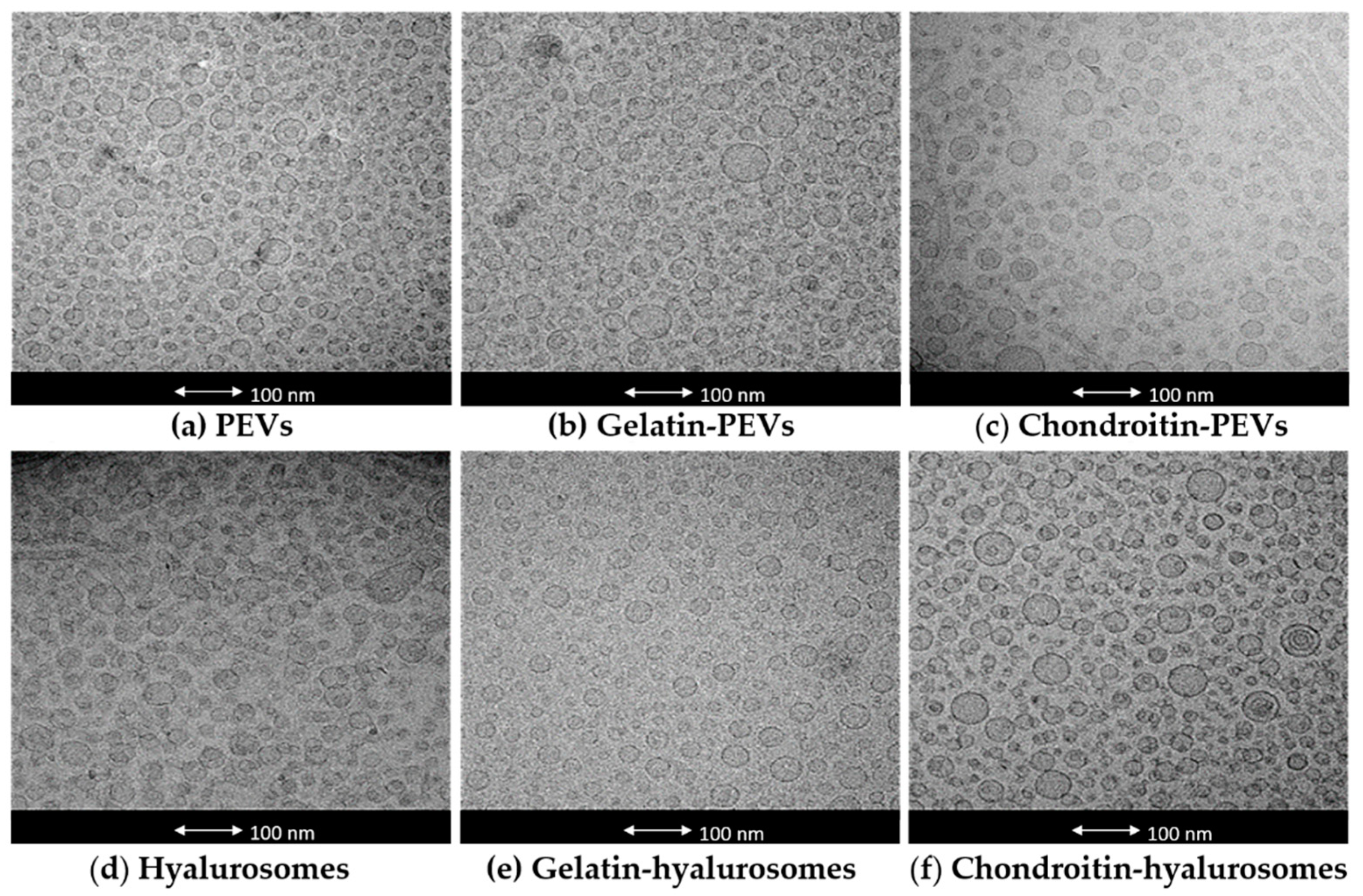

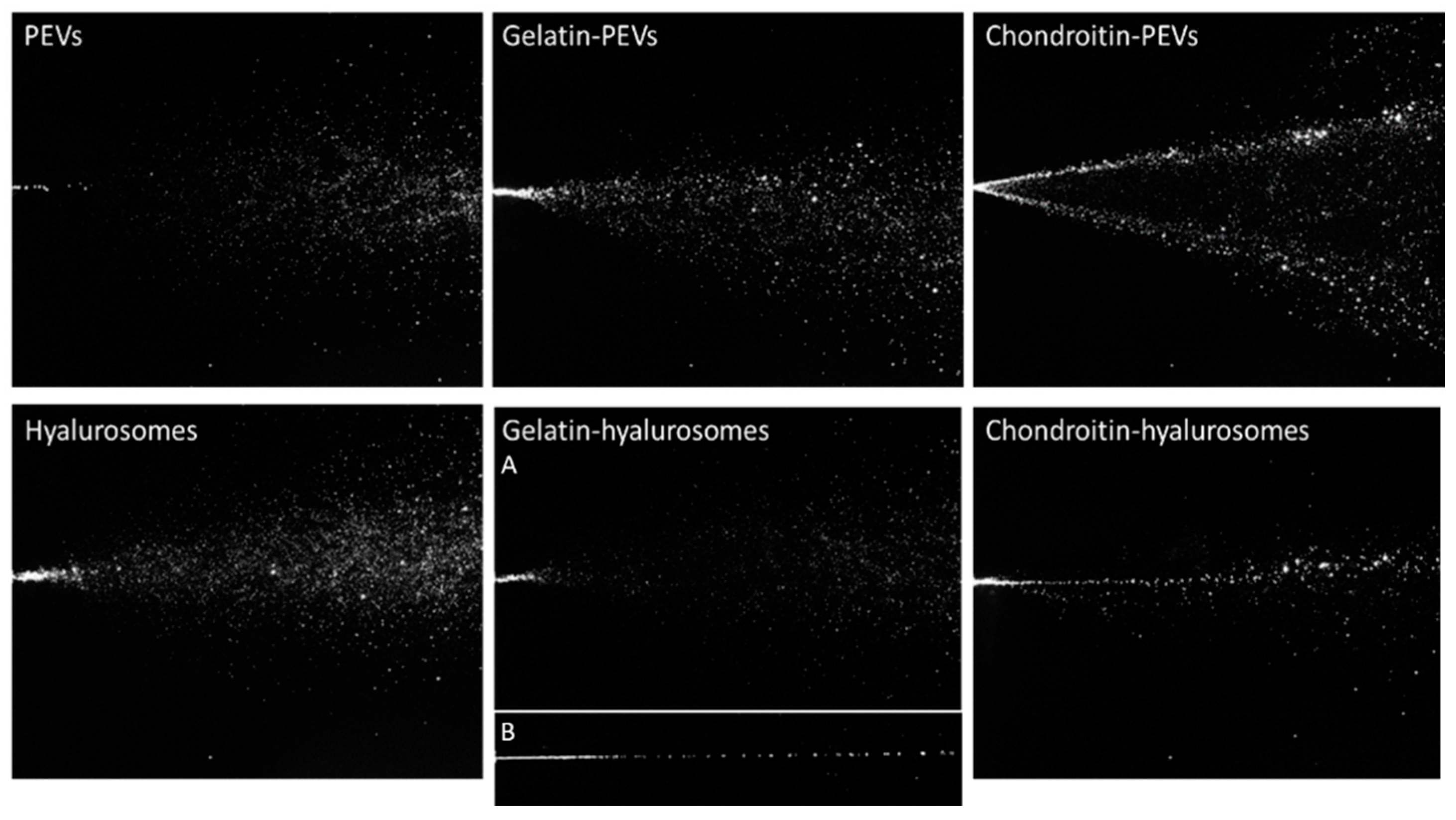
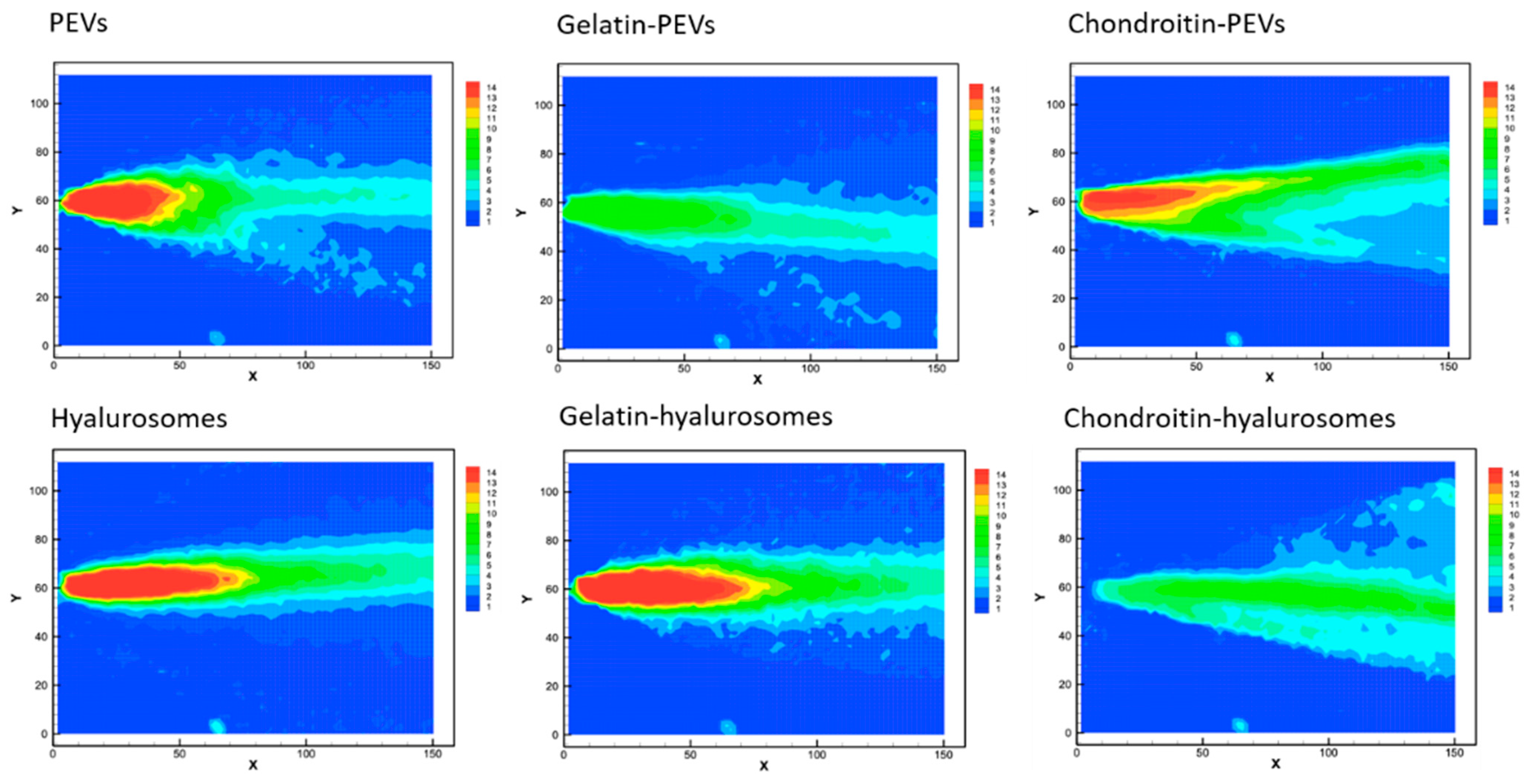
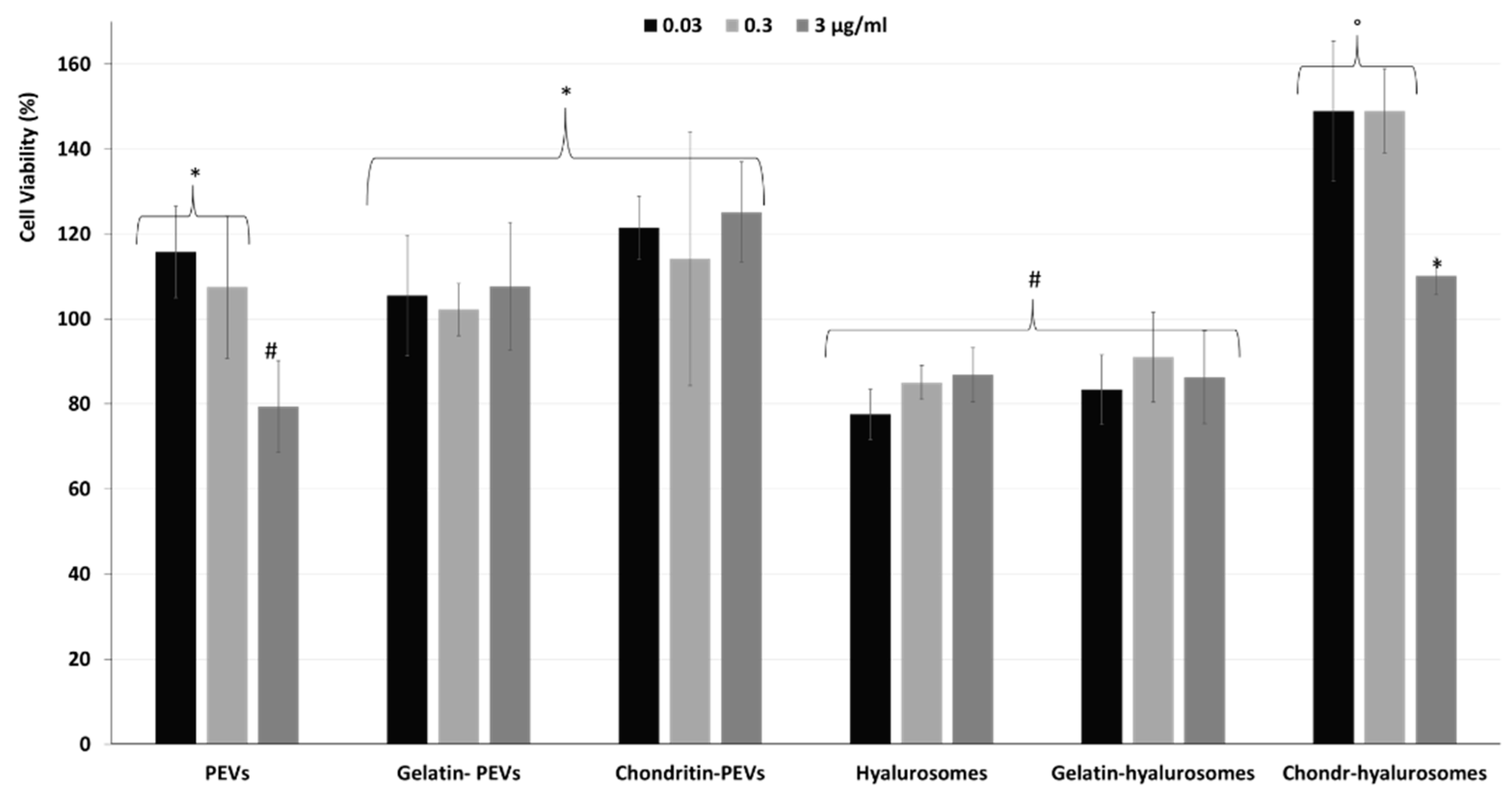
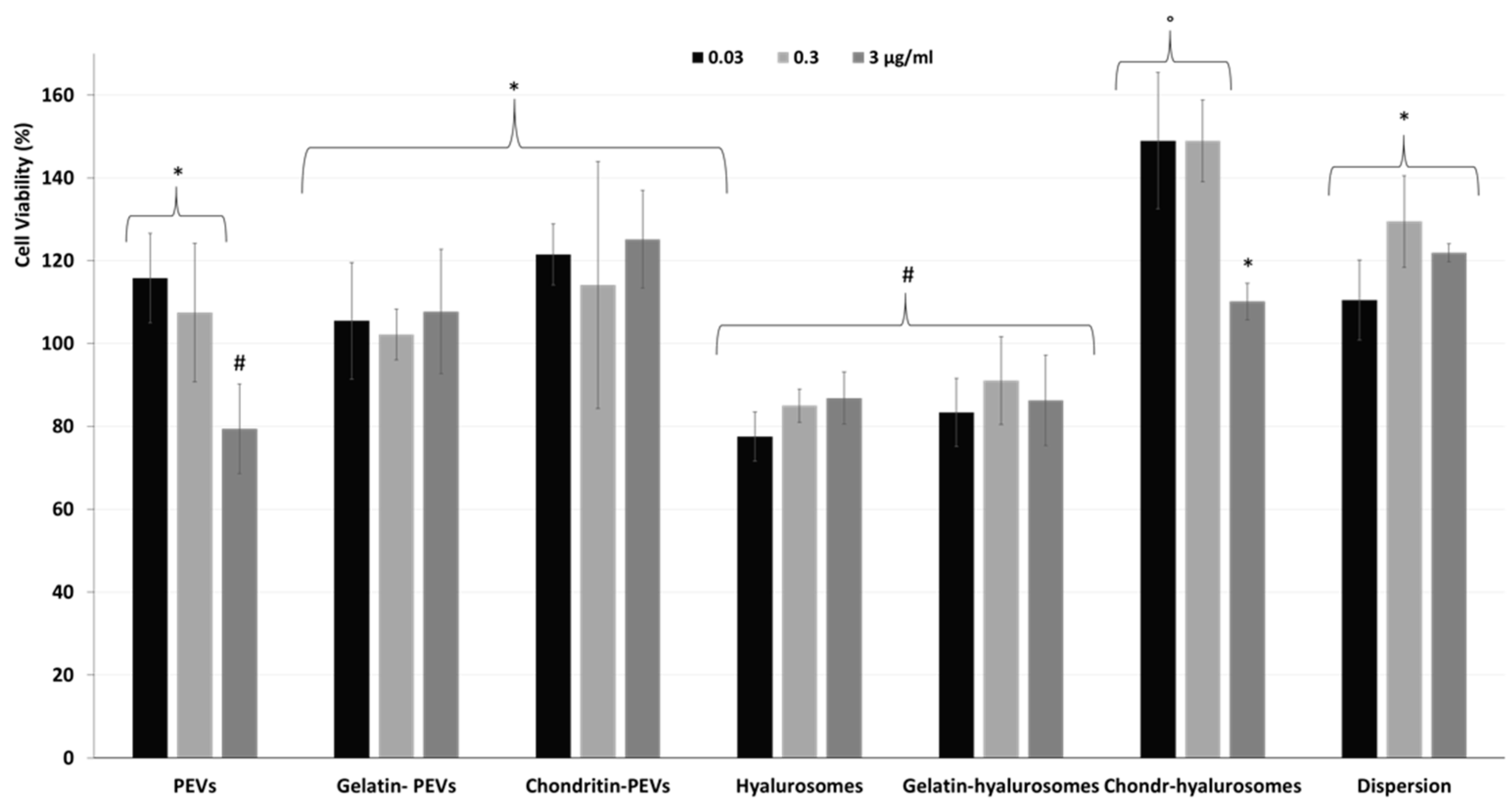
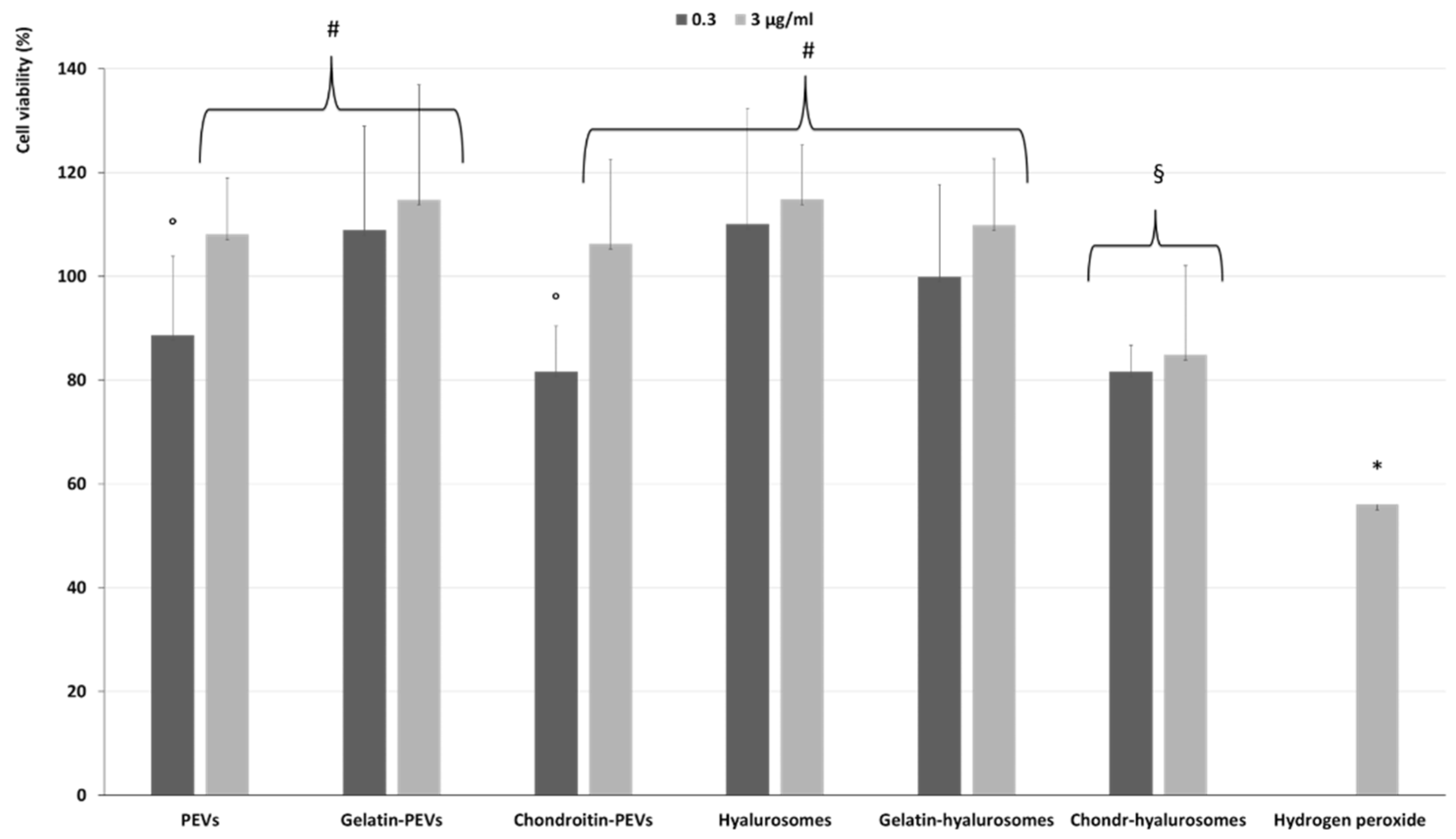
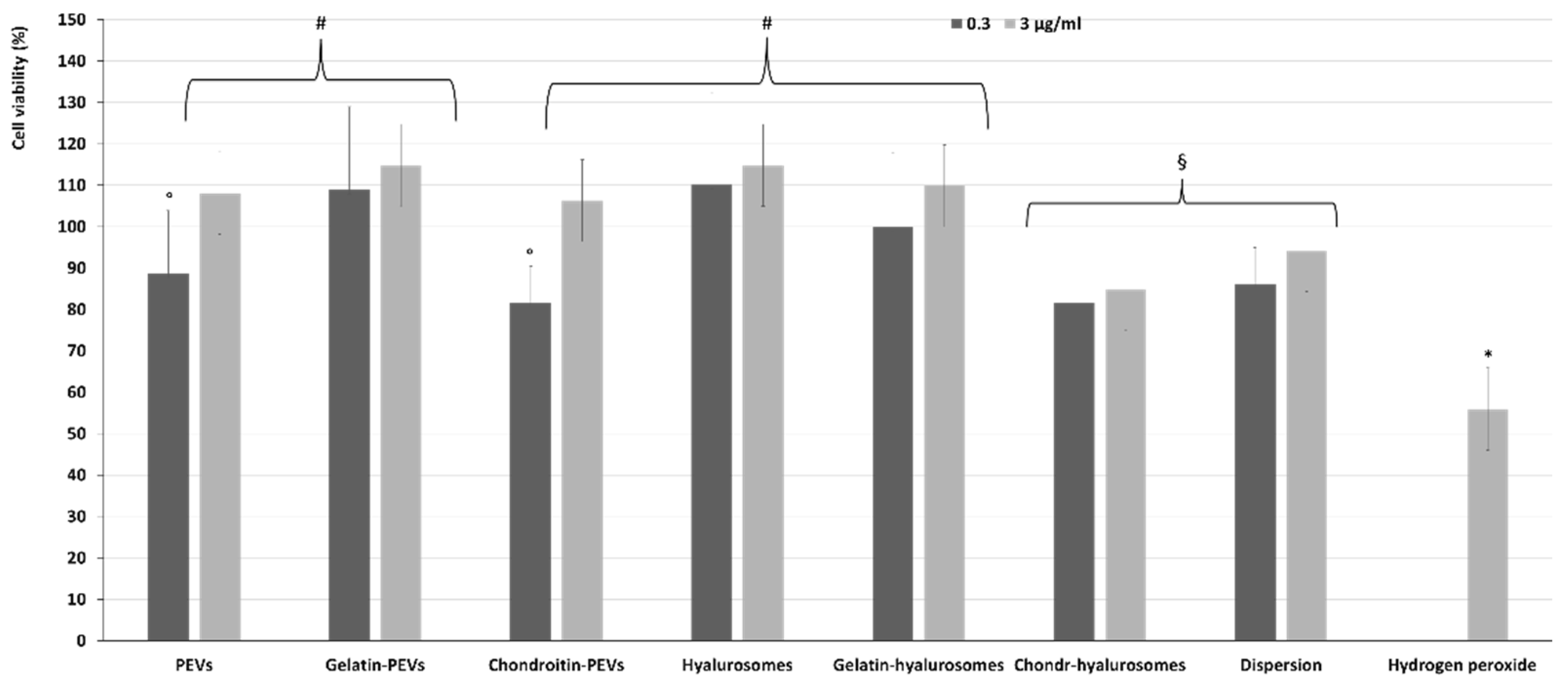
| MD (nm) | PI | ZP (mV) | EE (%) | |
|---|---|---|---|---|
| Empty PEVs | * 92 ± 2 | 0.23 | −67 ± 4 | |
| Empty gelatin-PEVs | + 175 ± 25 | 0.31 | −55 ± 7 | |
| Empty chondroitin-PEVs | #,* 117 ± 30 | 0.43 | −13 ± 3 | |
| Empty hyalurosomes | * 92 ± 3 | 0.45 | −21 ± 10 | |
| Empty gelatin-hyalurosomes | # 129 ± 3 | 0.13 | −30 ± 12 | |
| Empty chondroitin-hyalurosomes | § 154 ± 13 | 0.20 | −44 ± 10 | |
| PEVs | * 100 ± 20 | 0.43 | −48 ± 14 | * 99 ± 16 |
| Gelatin-PEVs | * 98 ± 4 | 0.63 | −25 ± 2 | ° 73 ± 36 |
| Chondroitin-PEVs | § 156 ± 23 | 0.23 | −46 ± 1 | ° 75 ± 10 |
| Hyalurosomes | ° 65 ± 6 | 0.26 | −45 ± 2 | 47 ± 13 |
| Gelatin-hyalurosomes | # 118 ± 8 | 0.30 | −23 ± 6 | * 93 ± 57 |
| Chondroitin-hyalurosomes | + 178 ± 6 | 0.09 | −55 ± 2 | ° 65 ± 9 |
| 4 cm | 7 cm | |||||||
|---|---|---|---|---|---|---|---|---|
| D10 (µm) | D50 (µm) | D90 (µm) | SPAN (µm) | D10 (µm) | D50 (µm) | D90 (µm) | SPAN (µm) | |
| PEVs | 29 ± 2 | *,+ 63 ± 18 | § 130 ± 46 | 2 ± 1 | 29 ± 2 | + 57 ± 1 | @ 173 ± 53 | 3 ± 1 |
| Gelatin-PEVs | 31 ± 3 | # 89 ± 10 | @ 185 ± 43 | 3 ± 1 | 31 ± 1 | * 66 ± 6 | @ 168 ± 50 | 4 ± 1 |
| Chondroitin-PEVs | 33 ± 2 | ° 69 ± 4 | § 131 ± 6 | 1 ± 0 | 30 ± 1 | * 47 ± 20 | § 118 ± 2 | 1 ± 0 |
| Hyalurosomes | 27 ± 1 | *,+ 59 ± 8 | § 154 ± 49 | 3 ± 1 | 33 ± 1 | * 61 ± 2 | @ 162 ± 76 | 4 ± 2 |
| Gelatin-hyalurosomes | 30 ± 1 | # 81 ± 9 | @ 171 ± 27 | 3 ± 1 | 33 ± 2 | ° 72 ± 2 | @ 196 ± 58 | 3 ± 1 |
| Chondroitin-hyalurosomes | 30 ± 3 | 102 ± 48 | 220 ± 27 | 3 ± 1 | 38 ± 5 | § 154 ± 129 | § 133 ± 30 | 4 ± 2 |
| High-Speed (M/S) | Spray Angle (°) | |
|---|---|---|
| PEVs | 13.9 | 29.7 |
| Gelatin-PEVs | 8.0 | 24.5 |
| Chondroitin-PEVs | 13.1 | 19.2 |
| Hyalurosomes | 15.2 | 20.7 |
| Gelatin-hyalurosomes | 15.1 | 25.4 |
| Chondroitin-hyalurosomes | 7.5 | - |
Publisher’s Note: MDPI stays neutral with regard to jurisdictional claims in published maps and institutional affiliations. |
© 2021 by the authors. Licensee MDPI, Basel, Switzerland. This article is an open access article distributed under the terms and conditions of the Creative Commons Attribution (CC BY) license (https://creativecommons.org/licenses/by/4.0/).
Share and Cite
Casula, E.; Manconi, M.; Vázquez, J.A.; Lopez-Mendez, T.B.; Pedraz, J.L.; Calvo, E.; Lozano, A.; Zaru, M.; Ascenso, A.; Manca, M.L. Design of a Nasal Spray Based on Cardiospermum halicacabum Extract Loaded in Phospholipid Vesicles Enriched with Gelatin or Chondroitin Sulfate. Molecules 2021, 26, 6670. https://doi.org/10.3390/molecules26216670
Casula E, Manconi M, Vázquez JA, Lopez-Mendez TB, Pedraz JL, Calvo E, Lozano A, Zaru M, Ascenso A, Manca ML. Design of a Nasal Spray Based on Cardiospermum halicacabum Extract Loaded in Phospholipid Vesicles Enriched with Gelatin or Chondroitin Sulfate. Molecules. 2021; 26(21):6670. https://doi.org/10.3390/molecules26216670
Chicago/Turabian StyleCasula, Eleonora, Maria Manconi, José Antonio Vázquez, Tania Belen Lopez-Mendez, José Luis Pedraz, Esteban Calvo, Antonio Lozano, Marco Zaru, Andreia Ascenso, and Maria Letizia Manca. 2021. "Design of a Nasal Spray Based on Cardiospermum halicacabum Extract Loaded in Phospholipid Vesicles Enriched with Gelatin or Chondroitin Sulfate" Molecules 26, no. 21: 6670. https://doi.org/10.3390/molecules26216670
APA StyleCasula, E., Manconi, M., Vázquez, J. A., Lopez-Mendez, T. B., Pedraz, J. L., Calvo, E., Lozano, A., Zaru, M., Ascenso, A., & Manca, M. L. (2021). Design of a Nasal Spray Based on Cardiospermum halicacabum Extract Loaded in Phospholipid Vesicles Enriched with Gelatin or Chondroitin Sulfate. Molecules, 26(21), 6670. https://doi.org/10.3390/molecules26216670










